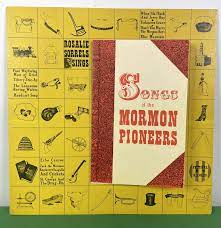Articles/Essays – Volume 01, No. 1
Saints of Song and Speech | Alice Parker, choral arrangements, The Mormon Pioneers
Columbia Records, that national giant of a record company, has beat someone to the punch. To prove that not all good things about Mormons must originate in the West, Goddard Lieberson has produced another of his excellent Legacy Series productions, this one about the Mormon pioneers. This “literary-musical essay” should straighten out any who are ignorant of their Mormon ancestry and forebears, or ashamed of them, and in a delightful, painless fashion. A forty-eight page historical booklet, crammed with pertinent photographs, maps, documents and sketches taken from nineteenth century Mormon history, is coordinated with an LP recording of folk songs and writings covering the same events. The total makes up a refreshing package of Mormon history in capsule form.
Carl Carmer, a non-Mormon historian from New York, and LeRoy Hafen, Professor of History at Brigham Young University, have authored excellent historical essays on early Mormon history. The two-page introductory article, “The Birth of the Mormon Church,” by Mr. Carmer, is choice reading. Not everyone will be pleased with its sensitive objectivity about a subject which more often evokes denouncements and slanderings or praise and veneration. But Carmer’s message is clear: The Mormon Church played a vital role in the development of frontier and Western America.
Mr. Hafen’s articles, “The Mormons on the Frontier,” and other, shorter pieces, are primarily vignettes of the main events of early Mormon history. Emphasis is rightfully placed on the Mormons’ role in the settlement of Utah and the surrounding states. Controversial points, such as polygamy and blood atonement, are wisely avoided. Only the bare facts are given about the pioneer trek in 1846 and 1847, the tragedy of the handcart companies, the encounter with Johnston’s Army, and the coming of the railroad. Yet one comes away from the written material rather well-informed on Mormon contributions to the settlement of the West. All told, the historical section has been executed with good taste and dosed out in amounts appropriate for the millions of people, Mormon, Jew and “Gentile,” whom the record will reach.
One feels inclined to “sing along” with the pioneers around their imaginary fires as one listens to “Tittery-irie-aye,” “Whoa, Ha, Buck, and Jerry Boy,” “On the Road to California,” “The Seagulls and the Crickets,” and “Once I lived in Cottonwood.” And it is really possible to sing too, because Thomas Cheney of the BYU English Department, besides preparing notes on each song’s background, has also provided us with the words. The large number of seldom-heard songs, all authentic, as Cheney’s researches attest, impresses us again with how much we do not know about our own heritage and culture.
The songs tell the Mormon pioneer story better, perhaps, than the printed word they follow. But just in case, Mr. Lieberson has interspersed selected readings, taken from the journals, letters and official documents of the period, which are read in a natural manner by authentic-sounding voices. This intricate interweaving of song and speech gives the album a continuity, unity, and vitality seldom found in historical recordings. One is left wanting more at the conclusion.
Much care has been taken to keep the songs and their musical presentation simple. No large symphony is heard in the background, and there is no mass chorus, except with the final number by the Tabernacle Choir. Modest guitar, banjo, or harmonica accompaniments add just the right amount of flavor. An old treadle organ provides an unusual but appropriate background for a letter written by Martha S. Haven on the persecutions of the early Saints. A snare drum lends atmosphere to simple renditions of “The Handcart Song” and “Johnston’s Army Song.” Male soloists or unison chorus handle the choral lines. The folk singers, undoubtedly professionals with Western or Southern accents, give a homespun air to the songs.
With the increased research into nineteenth and twentieth century Mormon culture by Mormons around the nation; with our expanding knowledge of authentic Mormon songs of the pioneer period; and with a growing number of Mormon folk-singers, the time is ripe for a more ambitious offering from within the Mormon culture itself. The Mormon Pioneers has taken a small but important first step. Others must soon follow if Mormon culture is to be preserved and passed on to a more urbane, but forgetful, generation.
The Mormon Pioneers. Solo selections by Jack Elliott and others. “Come, Come Ye Saints” by the Mormon Tabernacle Choir. Choral Arrangements by Alice Parker. Notes by Thomas E. Cheney. Columbia XLP 110084, 1965. $7.99, stereo $8.99.


 Back to full Issue
Back to full Issue

